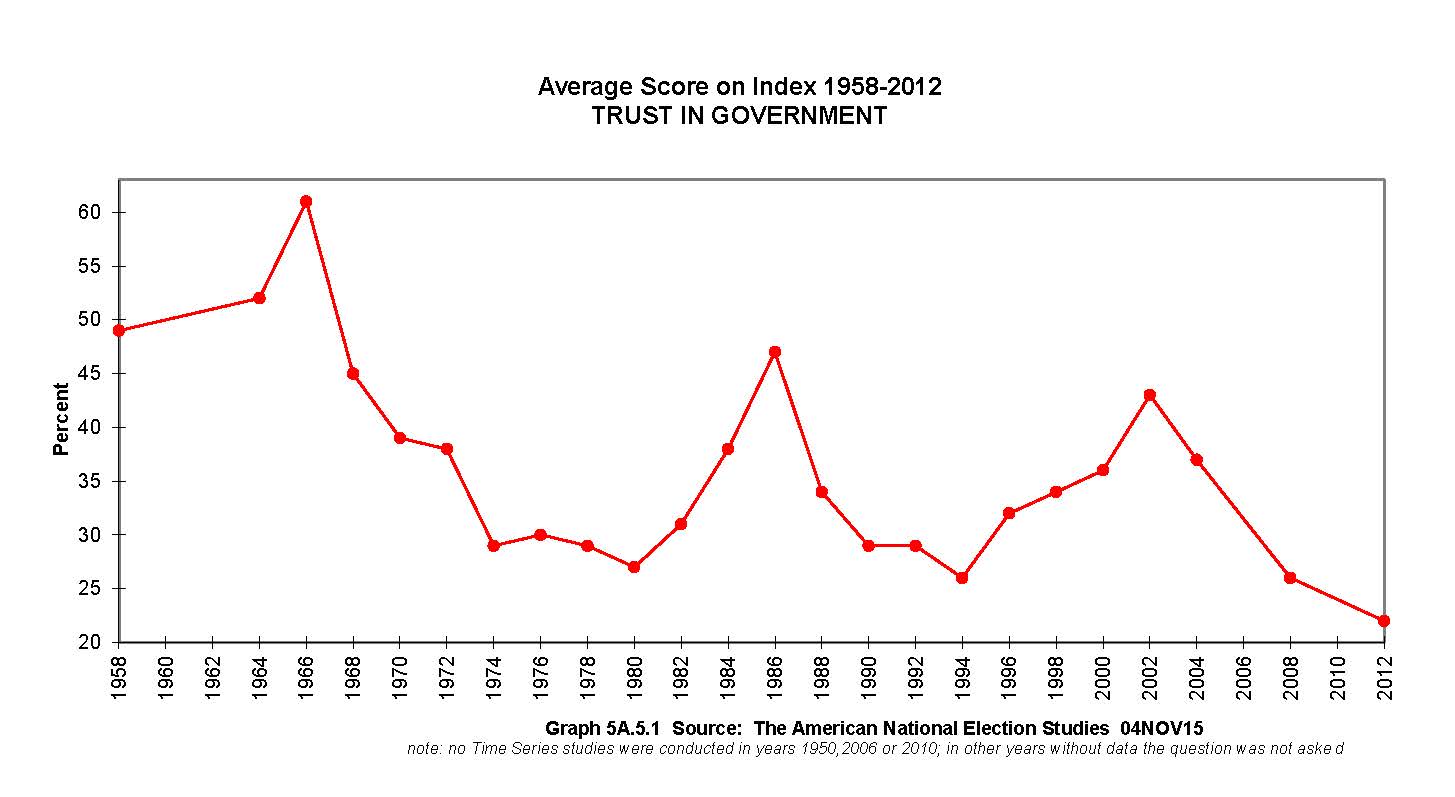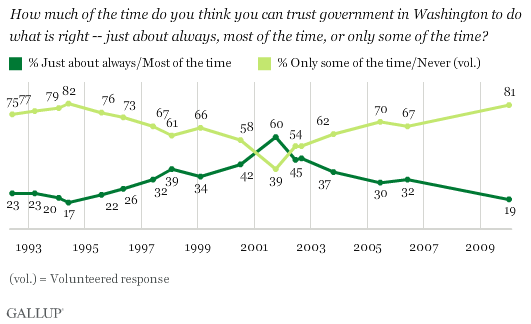This is not a post-election think piece. Lord knows we have enough of those already. It is not a To-Do List for the Brokenhearted. It’s not an assessment of blame, a hope-in-a-dark-place mantra, or a rallying cry.
This is just a statement of fact — a fact I believe sits at the heart of Tuesday’s election outcome — followed by what I think is a defensible conclusion, with evidence.
Here is the fact:
Public trust in our institutions of government has never been lower.
This isn’t breaking news, but it is notably absent from much of the soul-searching going on in the wake of this gobsmacking election outcome. Theories and explanations are rampant, and everyone’s words are on fire, giving off more heat than light. Through it all, this little reality sits largely unnoticed amid the sound and fury. I believe we ignore it at our peril.
Fairly or not, Democrats pay the price for this pervasive lack of trust in government. That’s because the fundamental difference between modern Democrats and Republicans revolves around their divergent visions for government’s proper role. To overgeneralize: Democrats believe government can and should be a force for good, while Republicans subscribe to the Reagan-era quip that the nine most terrifying words in the English language are, “I’m from the government and I’m here to help.”
Put simply, Republicans have won over the majority of the electorate to their way of thinking. And so, the conclusion:
As long as most of America mistrusts government, Democrats will never control the levers of American political power in a meaningful way that allows for the achievement of progressive policy goals over the long term.
Until faith in the promise of government is restored in the minds of a majority of Americans, Democrats will continue to lose. There will always be exceptions — once-in-a-lifetime politicians like Barack Obama who can build temporary winning coalitions — but that’s not a strategy. Anyone who wants to see liberal leaders elected and progressive policies enacted needs to focus on changing the public’s mind.
Guys, we need to fix our government.
Public perception of our government institutions
There was a lot of data about voter preferences going into the 2016 election. You can rest assured it will be dissected in painstaking detail in the postmortems to come.
But the over-analysis of demographic trends is unlikely to include this very simple chart, which I created with data from Gallup in about 15 minutes. It tells a jarring story about the growing distrust of our primary institutions of government:

Here is that same chart again, with trendlines:

Approval for Congress is especially low, having not eclipsed 20% in five years. Given these trajectories, it’s no surprise to see steady growth in public disdain for our politicians, which recently crossed the 50% threshold:

And finally, two disturbing charts that show how deeply our trust in government has fallen over the years. The American National Election Studies (ANES) show a dismal decline since 1958:

And Gallup’s general “trust in government” chart shows the negatives eclipsing the positives about 14 years ago:

You read that right: four out of five Americans trust the government in Washington to do the right thing “some of the time” or “never.” And — get this — “never” wasn’t even an option on the survey! It was volunteered as an answer by so many respondents that they included it in the reporting.
If progressives are the party that believes government can be a force for good, then the reality represented in these charts is an existential threat. It should be taken seriously, and a long-term strategy should be developed to address it.
It’s not for no reason
I spent four years working at the U.S. Government Accountability Office (GAO) in Washington, DC. GAO is a 3,000-person federal agency that tracks taxpayer dollars and evaluates the effectiveness of the programs on which they’re spent. It is valuable work, saving taxpayers about $134 for every dollar spent on the agency.
GAO churns out roughly 1,000 reports and congressional testimonies each year. The big joke in the agency is that each one could have pretty much the same title: “Some Progress Made, More Needed.” In most cases, federal programs are neither a raging boondoggle nor an unqualified success. There is always plenty of room for improvement.
And I do mean plenty. Some of the worst cases make the news, but I was continually amazed at the incredible range of opportunities our government misses to spend taxpayer dollars better. Most of these never get media coverage, because they’re not fraud or abuse — they’re just the boring, unfortunate result of poor management, outdated technology, unsophisticated workflow, or simple inertia.
And yet they add up to literally billions of dollars of potential savings, essentially left on the table. If you want to see some stunning examples, take five minutes and peruse GAO’s annually-updated Duplication & Cost Savings website. This two-and-a-half minute video overview highlights a few key cases as well:
I loved working in the federal government. The vast majority of people I met were smart and dedicated. But I also met more than a few less competent folks who were coasting along, in some cases for several decades, because it is extremely hard to fire federal employees. Along with huge cost centers like IT and procurement, personnel policies have not kept up with the outside world. Even within GAO, there were clearly visible opportunities to spend taxpayer dollars more effectively.
Realistically, very few of these opportunities could be realized overnight. Some would be quite thorny, and many would involve butting heads with traditional allies (such as unions). But they are all achievable. Anyway, if everyone’s contemplating Democrats’ reasons for existence in the wake of this election, the idea of embracing accountability for the structure on which our ideology depends should at least be in the mix…right?
When I would tell people I worked at the Government Accountability Office, at least every other person would make the same joke: “Government accountability? Isn’t that an oxymoron?” For Democrats seeking credibility and votes, therein lies the problem.
Okay, maybe this is a rallying cry after all
I don’t know about you, but if I never feel like I did on November 9th ever again, that would be great, thanks.
For me, that was actually a day of complicated emotions. Alongside President-elect Trump, I became Selectperson-elect Cluchey in my small town of Bowdoinham, Maine. It was both of our first time seeking elected office. Fortunately, my race involved substantially less vulgarity and fewer leaked videos (none, in fact). I am not currently commenting on my ties to Russia.
Running for office is not for everyone, though it should absolutely be for more people (please feel free to contact me if you are considering running in your community and would like to talk about it). But working for government in some capacity could be an option for many. The U.S. government is the world’s biggest employer, after all.
So, if you’re struggling with the reality of a Trump America and looking to effect systemic change, here’s an approach you might not have considered: Get a government job. Federal needs the most help, but state and local need you, too. Even if it’s just for a few years, find a public agency that could benefit from your expertise and energy, and get your resume in the pile. Think of it as a public service tour of duty.
Once you’re there, do everything in your power to make that agency a better and more attractive place to work, and to ensure it is providing the best possible service to taxpayers. In the meantime, read up on the brilliant work being done by folks like Jess McMullin at the Centre for Citizen Experience and Dana Chisnell and Whitney Quesenbery with the Center for Civic Design (not to mention the good people at Code for America, 18F, and USDS).
If getting a government job isn’t in the cards for you, then at the very least don’t talk down government. Avoid demeaning phrases like “good enough for government work.” Encourage young people to consider public sector jobs, and do what you can to remind your networks about the real and dedicated people who keep our machinery of democracy running.
This isn’t about infiltrating government to perpetuate a liberal agenda. It is about getting smart, energized people who believe government can be a force for good to put their money where their mouth is. So, this is not a drill: take your talents into the gray cubicles of government and make it work better for taxpayers.
Picture this
You go into the DMV to get a new license. When you walk in, a friendly person greets you and hands you a tablet. In a couple taps, you indicate the goals of your visit. Moments later you’re called in to have your photo taken. As you sit, another pleasant staff member asks you a few questions, marking your answers down on a form for you. Finally, you review the information, receive your new license, and walk out the door five minutes after you arrived.
This is not the typical citizen experience at the DMV. But it could be. And if it were, a party that endorsed governmental solutions to social challenges could expect to be quite a bit better-received at the polls.
At its best, government is a campfire. It’s a place in the wilderness where we can all gather together, get warm, and collaborate to build a stronger society and a safer world. To too many, that vision is unfamiliar; they know government as a faceless, monolithic bureaucracy where efficiency goes to die — or worse, as an entity that actively threatens their freedoms, as opposed to the structure we design and redesign together to enshrine them.
Fix that perception, and we may finally have a shot at some real, long term progressive change in this country. Being associated with government has become a liability for Democrats, but with work it could become a powerful advantage. Maybe we can even enlist some high-powered help.
In a couple months, President Obama will become that most potent of political superheroes: an ex-president. There would be no better ambassador for public service. Imagine the impact he could make by going school to school, extolling the virtues of this work to students. He could partner with groups like the Partnership for Public Service to spread the word about all the incredible, critical opportunities out there.
That would certainly be an auspicious start. But there is a lot of work to do. It won’t be easy, and it won’t be quick. Rebuilding trust takes time. But it is time well-spent, and it needs to happen.
So, what do you say? Are you good enough for government work?
This article was originally published on November 13, 2016, on Medium.